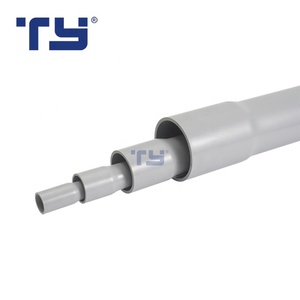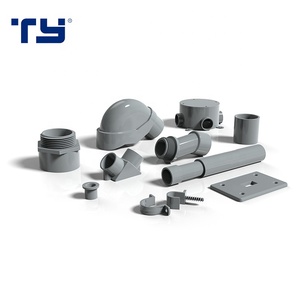(546 products available)

























































































































































































































An ASTM standard PVC conduit is a type of plastic electrical conduit made from polyvinyl chloride (PVC). It is used to protect and route electrical wiring in a variety of applications. PVC conduit is favored for its durability, resistance to moisture, and corrosion, and is lightweight compared to other conduit materials like metal. Here are the main types of ASTM standard PVC conduits:
Rigid PVC Conduit
Rigid PVC conduit is a non-metallic piping system designed to protect and insulate electrical wiring. This conduit is used in many electrical applications because it is lightweight and cost-effective. The electrical industry widely uses Rigid ASTM standard PVC conduit because it is easy to install and has a long service life. Rigid PVC conduits come in sizes ranging from 1 inch to 6 inches in diameter. They are usually available in white or gray colors.
Flexible PVC Conduit
Flexible plastic conduit is a non-metallic conduit system. It is constructed from a combination of PVC resins and other additives, which makes it flexible and durable. The application of this conduit includes wiring protection for appliances, HVAC systems, automotive wiring, and electronic devices. Flexible PVC conduits are popular in electrical installation because they are easy to install and provide a high level of protection for electrical wires. These conduits come in different diameters and sizes ranging from 0.5 inches to 4 inches.
Rigid and Flexible Recycled PVC Conduits
This type of conduit is constructed from recycled materials. Its application includes data centers, telecommunications, and power distribution networks. The conduit is popular for its environmental impact and cost-effectiveness. They are available in both rigid and flexible forms and are used in applications where large diamects are needed. Their diameters range from 1 inch to 8 inches.
ASTM D1784 and D3945 Schedule 40 and 80 PVC Conduit
This conduit is made according to the ASTM D1784 and D3945 standards. It is used in applications where high impact resistance and mechanical protection are needed. This conduit can be used for underground installations, above-ground installations, and in conduit-piping systems. They are popular in electrical applications because they are easy to install and have high corrosion resistance.
Electrical Safety:
Conduits help ensure electrical cables are installed safely, thus reducing the risks of electric shocks, electrical fires, and other hazards. The rigid and non-conductive nature of PVC conduits minimizes the risk of accidental contact or cable damage during installation or in the future.
Protection of Cables:
ASTM standard PVC conduits protect cables from impact, abrasion, chemical damage, and environmental hazards. This is particularly important in industrial settings where cables may be exposed to harsh conditions or physical damage. It also prevents rodents from chewing through the cables.
Moisture Control:
Helps prevent moisture from reaching the cables, which is important in preventing short circuits and other electrical problems. This is particularly important in areas with high humidity or where water is present.
Easy Installation:
PVC is lightweight and has smooth inner walls, which facilitates easy cable pulling and reduces friction during installation. Its ease of use and cost-effectiveness make it a preferred choice for many electrical installations.
Durability and Longevity:
ASTM standard PVC conduits are designed to be durable, offering long service life with minimal maintenance. They are resistant to UV radiation, moisture, and extreme temperatures, making them suitable for indoor and outdoor installations.
Fire Resistance:
Some PVC conduits have additives that improve their fire-retardant properties, helping to slow down the spread of fire and improve safety.
Corrosion Resistance:
PVC conduits are resistant to chemicals and moisture, making them suitable for use in environments with corrosive elements, such as underground installations or industrial settings.
Low Voltage Drop:
The smooth interior surface of PVC conduits helps reduce cable friction, minimizing voltage drop and improving the efficiency of electrical systems.
ASTM standard PVC conduits are used in many industries and applications because they protect electrical wiring systems. Here are some common usage scenarios:
Residential and commercial construction
ASTM standard PVC conduits are commonly used in residential and commercial construction projects. They are installed in walls, ceilings, and floors to protect electrical wiring for lighting, power outlets, and other electrical devices. These conduits are preferred because they are lightweight and easy to install. They are also resistant to moisture and chemicals, making them suitable for indoor applications.
Underground wiring
These conduits are used to protect electrical wiring that is installed underground. For example, in urban areas, electrical wiring is often installed underground to prevent damage from vehicles and to reduce the risk of electrical hazards. ASTM standard PVC conduits are used in this case because they are resistant to moisture and have a smooth interior surface that allows for easy pulling of wires. They are also lightweight and easy to handle, making them suitable for large-scale underground projects.
Data centers
Data centers use ASTM standard PVC conduits to protect and organize electrical wiring for servers, cooling systems, and other equipment. The conduits help to prevent electrical interference and ensure a reliable power supply to the equipment. Additionally, they facilitate easy maintenance and upgrades of the wiring system in data centers.
Renewable energy systems
These conduits are used in various renewable energy systems, such as solar power plants and wind farms. They protect the electrical wiring from solar panels, wind turbines, and other components. The conduits are used in these applications because they are lightweight, durable, and resistant to UV radiation. They also have a smooth interior surface that allows for easy pulling of wires in large-scale installations.
Industrial facilities
ASTM standard PVC conduits are used in industrial facilities, such as factories and warehouses, to protect electrical wiring for machinery, lighting, and other equipment. The conduits are installed in areas where they are exposed to dust, moisture, and chemicals. They are preferred in these applications because they are resistant to impact, corrosion, and UV radiation. Additionally, they have a smooth interior surface that allows for easy cleaning.
Consider the Size and Length:
When purchasing PVC conduits for electrical wiring, it is essential to determine the appropriate size and length required for each project. Different sizes accommodate varying numbers of electrical wires, with larger diameters allowing for more wires. Lengths also differ, with options available for cutting to the needed size. Properly assessing the dimensions ensures that the purchased conduits will be suitable for safe electrical installations.
Assess the Environment:
The environment where the conduit will be installed plays a crucial role in determining its type. For indoor installations, a standard PVC conduit is usually sufficient. However, if the conduit is to be installed in an area with high temperatures, a heat-resistant conduit is preferred. Likewise, in areas prone to severe weather conditions, a weather-resistant conduit is a better option. Therefore, it is essential to consider the environmental factors to ensure the right type of conduit is selected for each installation.
Check Certification:
Before purchasing PVC electrical conduits, it is essential to check their certification thoroughly. Certified conduits ensure that they have undergone the necessary tests and meet the required standards. This brings peace of mind, knowing that the installed conduits will be durable and will adequately protect electrical wiring. It is worth spending a little more on certified conduits instead of taking chances with uncertified ones.
Get Quotes from Multiple Suppliers:
Obtaining quotes from various suppliers is a prudent approach before making a purchase. This allows for price comparison and provides insight into the different types of PVC and their respective costs. While the price is an essential factor, it should not be the sole consideration when choosing a supplier. Other aspects, such as delivery time, customer service, and product quality, should also be taken into account.
Q1: What do the letters ASTM mean?
A1: The letters ASTM mean American Society for Testing and Materials. This organization establishes standard procedures for testing materials.
Q2: What are the two types of conduits?
A2: The two types of conduits are metal and non-metal. PVC is a non-metal conduit.
Q3: What does rigid mean in terms of PVC?
A3: The term rigid means that the material does not bend or curve easily. ASTM Standard PVC Conduit is a rigid type of PVC.
Q4: What is the standard wall thickness for PVC conduit?
A4: Schedule 40 has a thickness of 0.12 inches, while Schedule 80 has a thickness of 0.18 inches. The thick walls make it durable and able to withstand pressure.
Q5: What are the disadvantages of PVC?
A5: Some of the disadvantages of PVC are that it cannot be recycled easily, and extreme temperatures can affect its performance. Also, it is not biodegradable. However, its advantages outweigh the disadvantages.